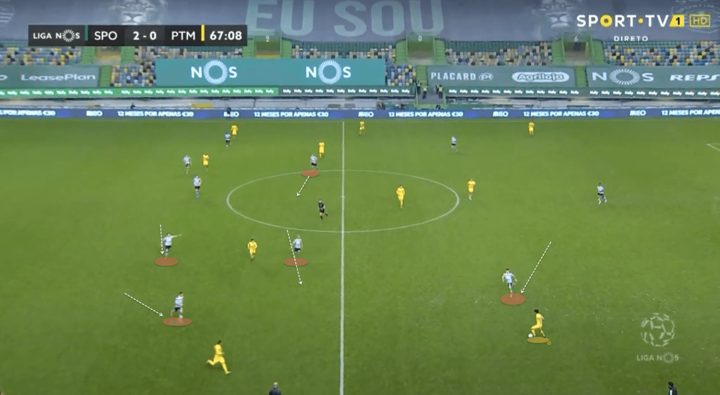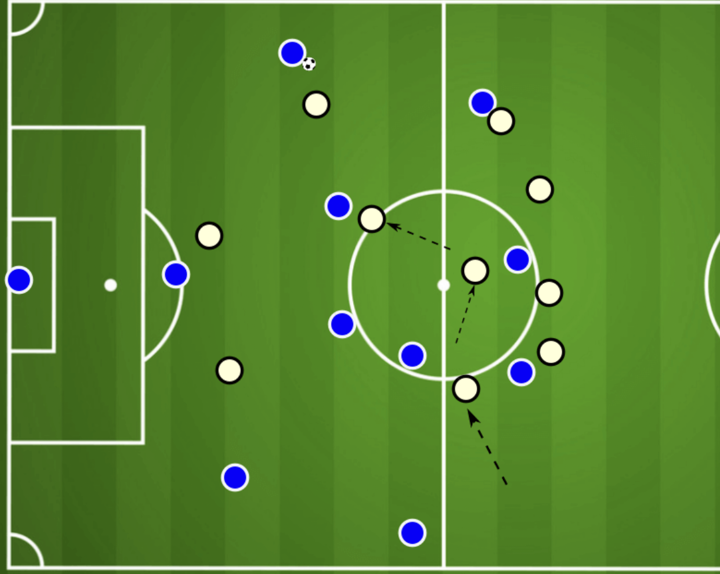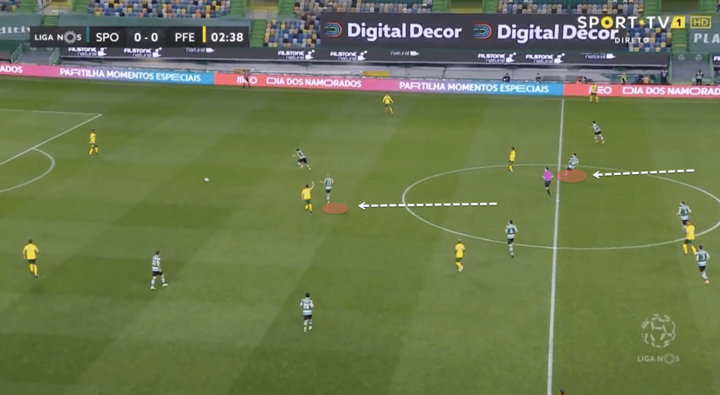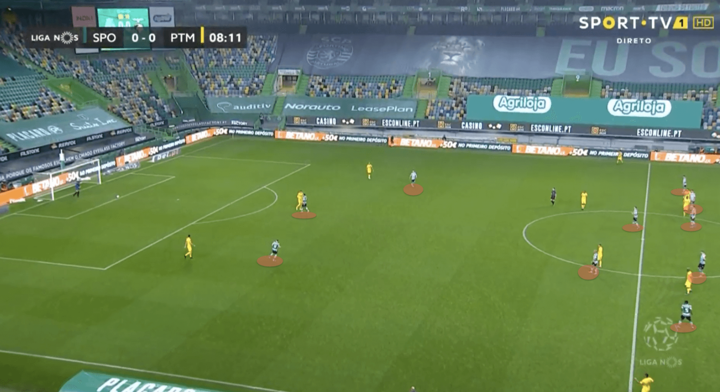Continue with yesterday's content, now we will analysis 5-2-3 formations with passing options and spaces for pivot
Closing off passing options
Sporting’s front three press the entirety of the opposition backline, working as a unit and preferably filtering the opposition down either flank. To do this they remain narrow and as a result show them away from the centre of the pitch.
The remit of the front three is to prevent easy central passage for the opposition, and then show them wide before closing out any passing options. Sporting then look to commit players to these wide areas where they can overload the opposition and subsequently secure possession on transition.
In the next image we can see that as the opposition play out wide, the ball-near wide forward shifts across and shows the player down the line. This move is followed by Sporting’s right wing-back shifting across and forwards to pick up the winger in support, whilst the ball-near pivot shifts across too. We can see this pattern in the following image, whilst the far-side pivot begins to move across to fill the central space.

When this happens Amorim wants to maintain protection in the centre of the pitch. Similar to how the three forwards and double pivot work in tandem to fill gaps when Sporting press, Amorim’s side do likewise to cover the opposition pivot.
Depending on ball location one of the defenders will drop in to cover the pivot pushing forward. If the ball is out wide, the far-side wing-back will drop inside to keep a double pivot.

Otherwise the centre-backs are given the freedom to drop into this area.

As alluded to in the introduction, Sporting have a fluid defensive shape and are more concerned with protecting specific spaces. There aren’t necessarily players assigned to roles. Just as either of the pivots might drop in to pick up the pivot space, the forwards will too.
In the following image as the ball is worked wide, Sporting’s centre-forward sees that the Portimonense pivot is shifting across and is in space, and with both of Sporting’s pivots unable to cover this space, he is able to drop in and cover. In doing so, Sporting continue to prevent an easy way out as the Portimonense right-winger has possession on the flank.

Similarly, any of the wide forwards can drop in to pick up the pivot, and allow Sporting’s own central-midfielders to remain in position.

No passes in behind
Unless the opponent have a player floating beyond Sporting’s first line of press, there’s no need to play with anyone in this space, and Sporting will happily play with a very reserved shape behind this front three.
As we can see in this image, the front three man-mark the opposition back three and therefore, force the opposition to play long. With the opponent having two wide players hugging each touchline, Sporting have a 7 v 5 overload in the centre of the pitch on the halfway line, and have the upper hand in the aerial duel and on the immediate loose ball duel afterwards.

Whilst their wing-backs will press the wide areas, they stay deep and compact until that pass is played. The aggressive press of their front three, and mobility of the double pivot pushes the opponent to play long, or play wide. If it goes wide, we have seen how they shut off any passing options, and if they go long this five have the upper hand.
Their ability to cover the width of the pitch also prevents any through-pass that isn’t an aerial ball. If the opponent does break through the press in a central area, the immediate pressure from the centre from one of the pivots, and Sporting’s back five covering any potential gaps for a quick pass in behind, makes it very difficult for them to be broken down.
Conclusion
Sporting show that if a front three work well together as a unit and maintain an intense press, then wingers or significant numbers in central midfield aren’t necessarily important in a defensive system.
Sporting instead know they can force opponents into areas of the pitch where they can significantly reduce their chances of building up in a way that the opposition have planned to. They can lead them into wide areas where they shut off any potential passing options and either turnover possession or force the opponent to play long.
